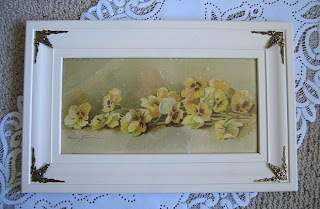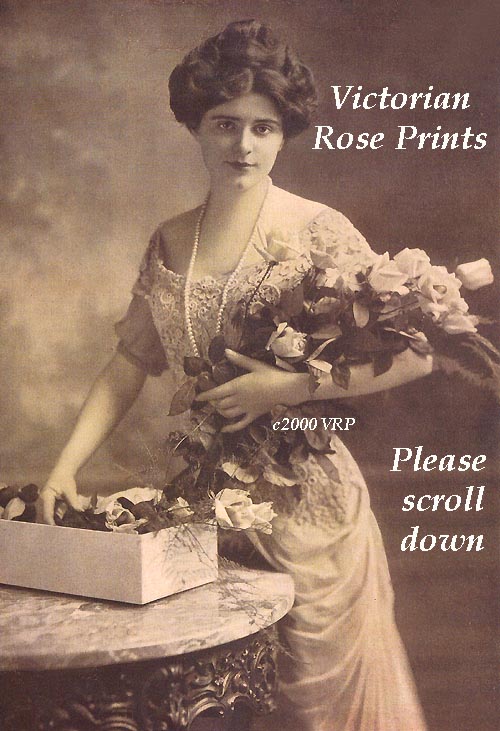 lack, and they have many outstanding qualities that are not duplicated today. Rose prints fascinated ladies well before the Victorian era, and are just as popular with women today. Garden roses are highly collectible, and are becoming more scarce each day. The shabby chic and romantic cottage themes have pushed these prints to the forefront of collecting, as folks scramble to decorate their homes with a vintage flair. They are the perfect companion not only for the shabby look, but also compliment the elegant décor and rich patina paints.
lack, and they have many outstanding qualities that are not duplicated today. Rose prints fascinated ladies well before the Victorian era, and are just as popular with women today. Garden roses are highly collectible, and are becoming more scarce each day. The shabby chic and romantic cottage themes have pushed these prints to the forefront of collecting, as folks scramble to decorate their homes with a vintage flair. They are the perfect companion not only for the shabby look, but also compliment the elegant décor and rich patina paints.Let’s chat about the old COLOR prints, those dating to the late 1890’s. Louis Prang was the first to introduce the process of chromolithography (in 1860), and it was this method that gave prints their color qualities. Prior to that time, prints were hand-colored with watercolor paints. (A good example of this venue can be seen in Godey’s Lady's Book, their dress attire.) In a nutshell, chromolithography required that a single stone be constructed for each color hue. As many as twenty-two stones may have been required to create a single image. Each inked stone was meticulously laid down, one at a time, atop previous color layers. All of the stones had to be in perfect alignment, or register, or the image would appear blurry.
Because of the rich layering of oil-based inks, “chromos” appear as if
 they have an almost pearly sheen when tilted from side to side. Often the color layers would bleed through to the reverse of the print. Chromolithographs have no equal, they are truly magnificent, not only in their stunning image quality, but also in the time-consuming manner used to create them. It is possible that you may see a print only once in a whole lifetime of collecting, because not all finished proofs went into production.
they have an almost pearly sheen when tilted from side to side. Often the color layers would bleed through to the reverse of the print. Chromolithographs have no equal, they are truly magnificent, not only in their stunning image quality, but also in the time-consuming manner used to create them. It is possible that you may see a print only once in a whole lifetime of collecting, because not all finished proofs went into production.When examining a chromolithograph, it is best to use a magnifying glass. Peer closely at the color pattern in a light tonal area, and you should see a random pattern of irregular-sized dots. This is the true test to determine a chromo. It is quite easy to see the color layering. Chromolithography was virtually extinct by 1900 when photolithography came into vogue.
Photolithography is the printing process used today. When this pattern is viewed with a magnifying glass, it appears more like a fine grid or mesh, similar to a window screen. Even with a magnifying glass, look closely, as some new prints still have the dots incorporated into the grid pattern. Unfortunately, since photolithography is still in use today, it is difficult to determine if a print is old or new with magnification, other than an examination of the paper used to determine its age.
Are there pitfalls associated with collecting old prints? Of course there are! I have been collecting the old prints for 35 years, so let me share some tips. There are many things to consider, but quality is first and foremost. Blemishes, such as rips, tears, repairs, paper ripples, watermarks, and foxing (paper mold) are unsightly and very common in old prints. Often prints were hung over fireplaces. As you can imagine, the air space between the glass and print got very hot, and when it cooled down, condensation occurred, creating unsightly watermarks.
In the case of the chromolithograph, the oily inks sometimes caused the print to adhere to the glass. When this happens, it is stuck FOREVER. Removing the print results in tidbits of ink popping off the paper and sticking to the glass. One visual indicator might be little spots of darker coloring throughout the print, or white spots where you can see the print has already lifted off the glass. In almost all cases, when the print is taken out of the frame, the print can never be re-aligned perfectly so that the particles line up again. Blemishes in the white margin area of a print can be acceptable, especially if rematting, which would cover the flaws. Some imperfections are easy to notice, and you would think sellers would disclose all problems, but often they don’t see a flaw as a problem area. What is perfect condition to them may not be acceptable in your eyes. RULE NUMBER 1: YOU MUST ASK QUESTIONS. Small photographs can only reveal so much. Even if you cannot see flaws, ask if they are present. All too often I see a print description that says excellent, but alas, it has rips, creases, or it might even be pasted to an old scrapbook page! Photographs can easily hide flaws. Again, ask questions, even if does look great! Look for a reputable dealer, one who has been in the business for many years, someone with experience who is always pleased to thoroughly answer your questions.
 Price depends on many factors, such as: condition, rarity, and who is willing to buy it (the “gotta have” syndrome). Keep a price in mind, but if you do pay a higher price, you may want to consider finding a print in very good to fine condition. All too often, buyers find themselves with buyer’s remorse after purchasing a print with a major blemish. Afterwards, their eye always focuses on the specific problem area, and sadly, they find their treasure disappointing and unfulfilling. Just remember, you can always “trade up”, selling your old blemished print when you find one in better condition. Lastly, don’t let “the thrill of the chase” sway your decision!
Price depends on many factors, such as: condition, rarity, and who is willing to buy it (the “gotta have” syndrome). Keep a price in mind, but if you do pay a higher price, you may want to consider finding a print in very good to fine condition. All too often, buyers find themselves with buyer’s remorse after purchasing a print with a major blemish. Afterwards, their eye always focuses on the specific problem area, and sadly, they find their treasure disappointing and unfulfilling. Just remember, you can always “trade up”, selling your old blemished print when you find one in better condition. Lastly, don’t let “the thrill of the chase” sway your decision!So how does one arrive at the correct price? This is the age-old question, and keeps getting more complicated every day. The internet is a great place to start. Scour the sites you know sell old prints and see what prices they command. Bear in mind that auction or bidding site prices are subject to holiday fluctuations. Auction houses are also a source, but you MUST ask for additional photos, and ask about blemishes…never take those photos you see for granted. With the introduction of the internet, the grand old rose prints, those in superb condition, are indeed difficult to find—it’s as simple as the rule of supply and demand. Old chromolithographs are becoming scarce, there’s no doubt they are extremely popular. So, when you find a rose print that calls out your name, don’t wait too long to make your purchase, as someone else may come in and buy it right out from underneath you!
I’m often asked “Shall I reframe the print, or leave it as is?” Good question! There are those folks who want everything historically intact, even if the frame is broken down and it’s falling apart. Another school of thought is to reframe the print, conserving it. Either way, it’s personal preference. Most of the old prints from the 1890’s were backed with wooden shingle. Over time, the wood resins leached into the print and caused blemishes, such as brown lines, and knothole burns. At the very least, replace the wooden shingle with a new, acid-free foam core backing. You’ll have peace of mind, and the foam core often flattens down the print so that the waviness disappears. If the frame is deteriorating, at least keep the old glass for your new frame. There is nothing like the old wavy, bubbled, imperfect glass. It truly does dance when you walk by it, reminding you of the old days. If your print doesn’t have the old glass, and you’d prefer it, head on over to your local stained glass shop. Many of them now carry glass that truly mimics the old glass, and it’s quite a beautiful substitute. Flemish and seeded glasses are gorgeous!
One last thought…there are many artists of the late 1890 period who “crossed over”, and their prints were made with both processes, chromolithography and photolithography. An example is the French Victorian watercolorist, Paul de Longpre (b. 1855, d. 1911). It just depends when their prints were produced, in this case, between 1880 and 1911. Because of de Longpre’s popularity, some of his prints were republished in the 1940’s.
In closing, the old rose compositions certainly have that Victorian romantic attraction we all love, and retain their values exceedingly well. Antique rose prints never seem to lose their charm, and are a beautiful addition to the home decor. A good investment?...yes indeed!
Visit this store: Victorian Rose Prints












